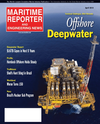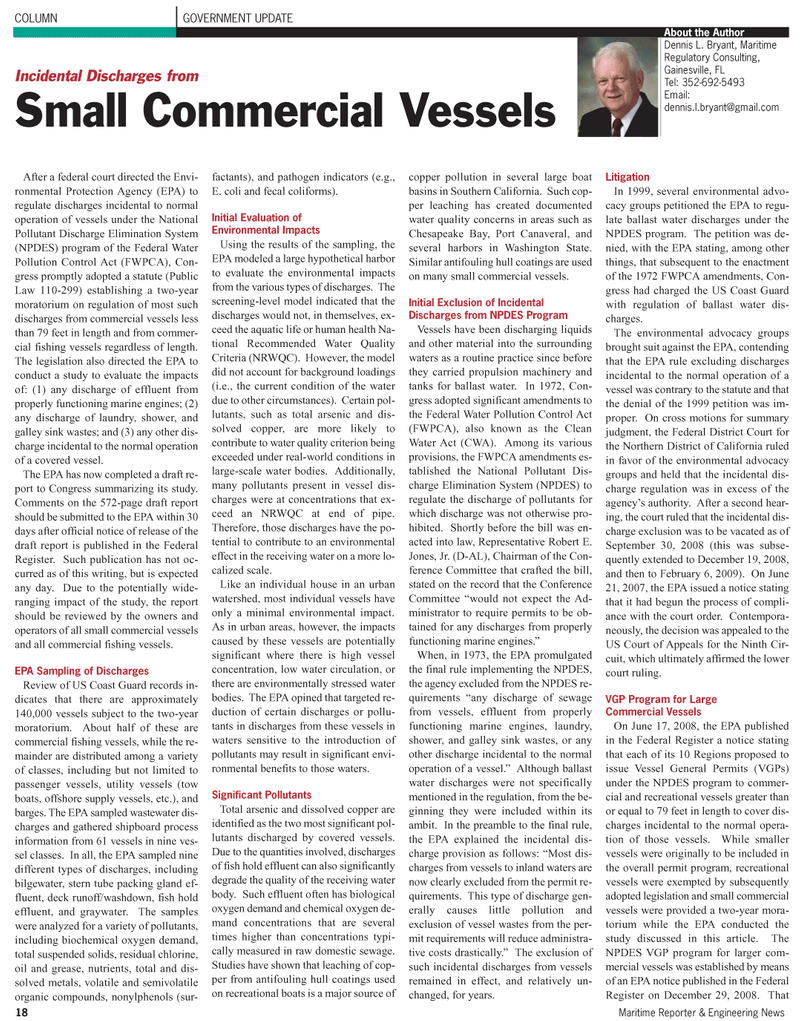
Page 18: of Maritime Reporter Magazine (April 2, 2010)
Read this page in Pdf, Flash or Html5 edition of April 2, 2010 Maritime Reporter Magazine
After a federal court directed the Envi- ronmental Protection Agency (EPA) to regulate discharges incidental to normal operation of vessels under the National
Pollutant Discharge Elimination System (NPDES) program of the Federal Water
Pollution Control Act (FWPCA), Con- gress promptly adopted a statute (Public
Law 110-299) establishing a two-year moratorium on regulation of most such discharges from commercial vessels less than 79 feet in length and from commer- cial fishing vessels regardless of length.
The legislation also directed the EPA to conduct a study to evaluate the impacts of: (1) any discharge of effluent from properly functioning marine engines; (2) any discharge of laundry, shower, and galley sink wastes; and (3) any other dis- charge incidental to the normal operation of a covered vessel.
The EPA has now completed a draft re- port to Congress summarizing its study.
Comments on the 572-page draft report should be submitted to the EPA within 30 days after official notice of release of the draft report is published in the Federal
Register. Such publication has not oc- curred as of this writing, but is expected any day. Due to the potentially wide- ranging impact of the study, the report should be reviewed by the owners and operators of all small commercial vessels and all commercial fishing vessels.
EPA Sampling of Discharges
Review of US Coast Guard records in- dicates that there are approximately 140,000 vessels subject to the two-year moratorium. About half of these are commercial fishing vessels, while the re- mainder are distributed among a variety of classes, including but not limited to passenger vessels, utility vessels (tow boats, offshore supply vessels, etc.), and barges. The EPA sampled wastewater dis- charges and gathered shipboard process information from 61 vessels in nine ves- sel classes. In all, the EPA sampled nine different types of discharges, including bilgewater, stern tube packing gland ef- fluent, deck runoff/washdown, fish hold effluent, and graywater. The samples were analyzed for a variety of pollutants, including biochemical oxygen demand, total suspended solids, residual chlorine, oil and grease, nutrients, total and dis- solved metals, volatile and semivolatile organic compounds, nonylphenols (sur- factants), and pathogen indicators (e.g.,
E. coli and fecal coliforms).
Initial Evaluation of
Environmental Impacts
Using the results of the sampling, the
EPA modeled a large hypothetical harbor to evaluate the environmental impacts from the various types of discharges. The screening-level model indicated that the discharges would not, in themselves, ex- ceed the aquatic life or human health Na- tional Recommended Water Quality
Criteria (NRWQC). However, the model did not account for background loadings (i.e., the current condition of the water due to other circumstances). Certain pol- lutants, such as total arsenic and dis- solved copper, are more likely to contribute to water quality criterion being exceeded under real-world conditions in large-scale water bodies. Additionally, many pollutants present in vessel dis- charges were at concentrations that ex- ceed an NRWQC at end of pipe.
Therefore, those discharges have the po- tential to contribute to an environmental effect in the receiving water on a more lo- calized scale.
Like an individual house in an urban watershed, most individual vessels have only a minimal environmental impact.
As in urban areas, however, the impacts caused by these vessels are potentially significant where there is high vessel concentration, low water circulation, or there are environmentally stressed water bodies. The EPA opined that targeted re- duction of certain discharges or pollu- tants in discharges from these vessels in waters sensitive to the introduction of pollutants may result in significant envi- ronmental benefits to those waters.
Significant Pollutants
Total arsenic and dissolved copper are identified as the two most significant pol- lutants discharged by covered vessels.
Due to the quantities involved, discharges of fish hold effluent can also significantly degrade the quality of the receiving water body. Such effluent often has biological oxygen demand and chemical oxygen de- mand concentrations that are several times higher than concentrations typi- cally measured in raw domestic sewage.
Studies have shown that leaching of cop- per from antifouling hull coatings used on recreational boats is a major source of copper pollution in several large boat basins in Southern California. Such cop- per leaching has created documented water quality concerns in areas such as
Chesapeake Bay, Port Canaveral, and several harbors in Washington State.
Similar antifouling hull coatings are used on many small commercial vessels.
Initial Exclusion of Incidental
Discharges from NPDES Program
Vessels have been discharging liquids and other material into the surrounding waters as a routine practice since before they carried propulsion machinery and tanks for ballast water. In 1972, Con- gress adopted significant amendments to the Federal Water Pollution Control Act (FWPCA), also known as the Clean
Water Act (CWA). Among its various provisions, the FWPCA amendments es- tablished the National Pollutant Dis- charge Elimination System (NPDES) to regulate the discharge of pollutants for which discharge was not otherwise pro- hibited. Shortly before the bill was en- acted into law, Representative Robert E.
Jones, Jr. (D-AL), Chairman of the Con- ference Committee that crafted the bill, stated on the record that the Conference
Committee “would not expect the Ad- ministrator to require permits to be ob- tained for any discharges from properly functioning marine engines.”
When, in 1973, the EPA promulgated the final rule implementing the NPDES, the agency excluded from the NPDES re- quirements “any discharge of sewage from vessels, effluent from properly functioning marine engines, laundry, shower, and galley sink wastes, or any other discharge incidental to the normal operation of a vessel.” Although ballast water discharges were not specifically mentioned in the regulation, from the be- ginning they were included within its ambit. In the preamble to the final rule, the EPA explained the incidental dis- charge provision as follows: “Most dis- charges from vessels to inland waters are now clearly excluded from the permit re- quirements. This type of discharge gen- erally causes little pollution and exclusion of vessel wastes from the per- mit requirements will reduce administra- tive costs drastically.” The exclusion of such incidental discharges from vessels remained in effect, and relatively un- changed, for years.
Litigation
In 1999, several environmental advo- cacy groups petitioned the EPA to regu- late ballast water discharges under the
NPDES program. The petition was de- nied, with the EPA stating, among other things, that subsequent to the enactment of the 1972 FWPCA amendments, Con- gress had charged the US Coast Guard with regulation of ballast water dis- charges.
The environmental advocacy groups brought suit against the EPA, contending that the EPA rule excluding discharges incidental to the normal operation of a vessel was contrary to the statute and that the denial of the 1999 petition was im- proper. On cross motions for summary judgment, the Federal District Court for the Northern District of California ruled in favor of the environmental advocacy groups and held that the incidental dis- charge regulation was in excess of the agency’s authority. After a second hear- ing, the court ruled that the incidental dis- charge exclusion was to be vacated as of
September 30, 2008 (this was subse- quently extended to December 19, 2008, and then to February 6, 2009). On June 21, 2007, the EPA issued a notice stating that it had begun the process of compli- ance with the court order. Contempora- neously, the decision was appealed to the
US Court of Appeals for the Ninth Cir- cuit, which ultimately affirmed the lower court ruling.
VGP Program for Large
Commercial Vessels
On June 17, 2008, the EPA published in the Federal Register a notice stating that each of its 10 Regions proposed to issue Vessel General Permits (VGPs) under the NPDES program to commer- cial and recreational vessels greater than or equal to 79 feet in length to cover dis- charges incidental to the normal opera- tion of those vessels. While smaller vessels were originally to be included in the overall permit program, recreational vessels were exempted by subsequently adopted legislation and small commercial vessels were provided a two-year mora- torium while the EPA conducted the study discussed in this article. The
NPDES VGP program for larger com- mercial vessels was established by means of an EPA notice published in the Federal
Register on December 29, 2008. That 18 Maritime Reporter & Engineering News
COLUMN GOVERNMENT UPDATE
Incidental Discharges from
Small Commercial Vessels
About the Author
Dennis L. Bryant, Maritime
Regulatory Consulting,
Gainesville, FL
Tel: 352-692-5493
Email: [email protected]

 17
17

 19
19
